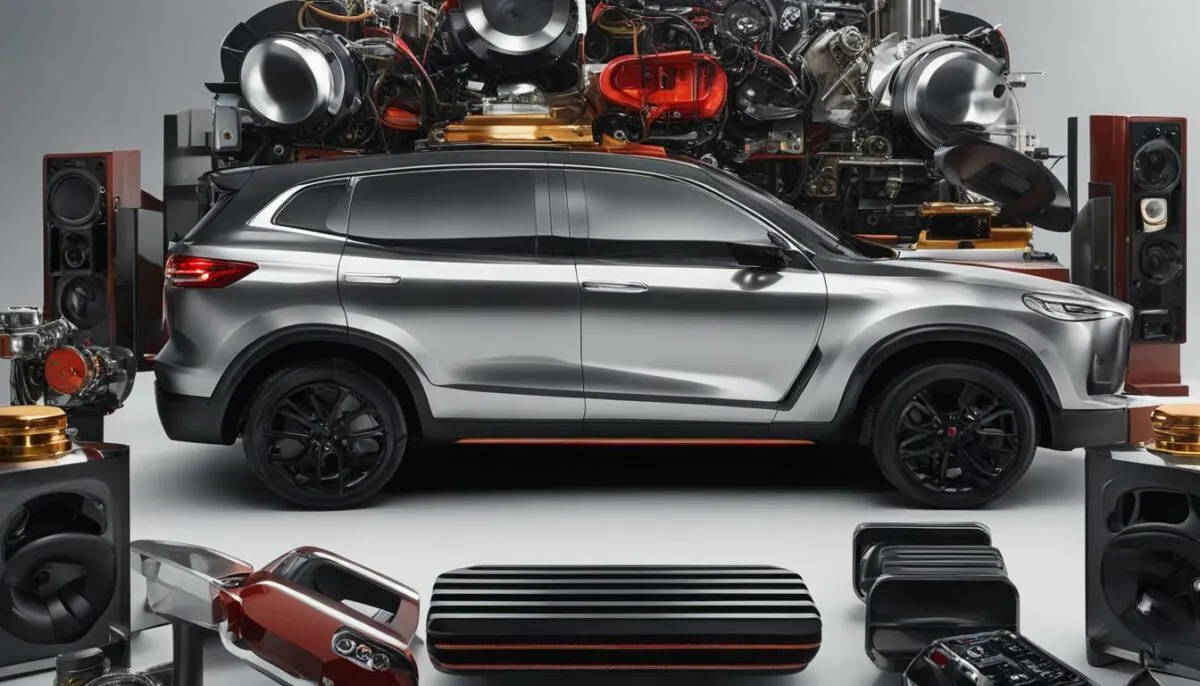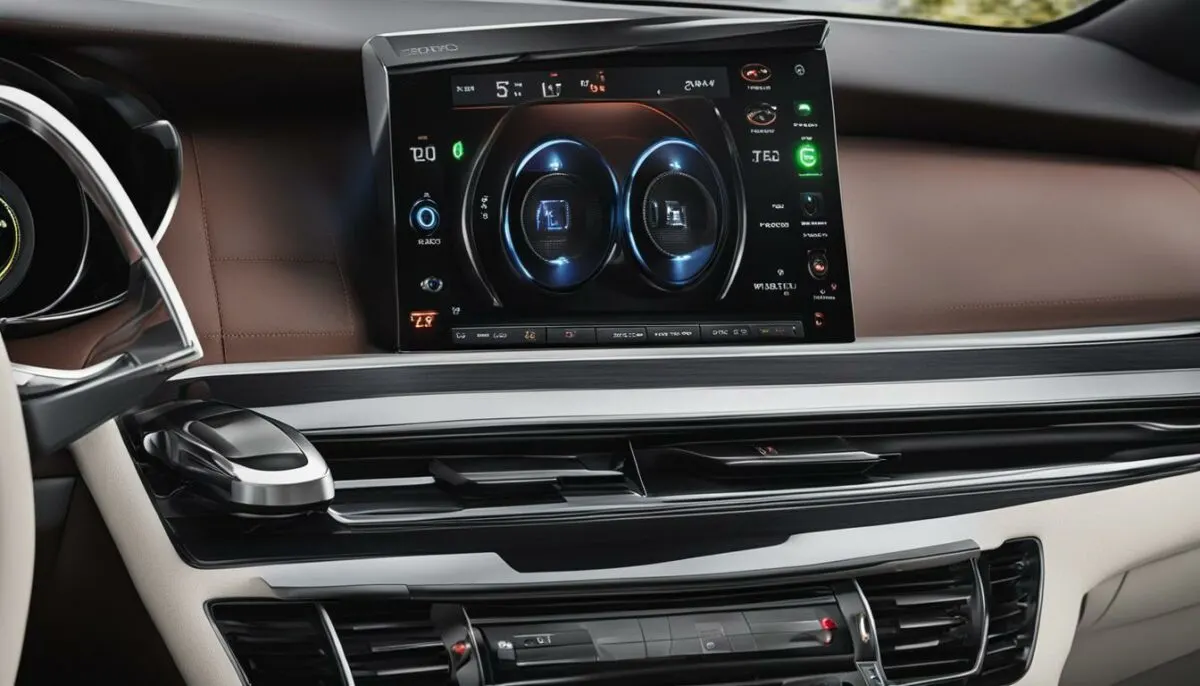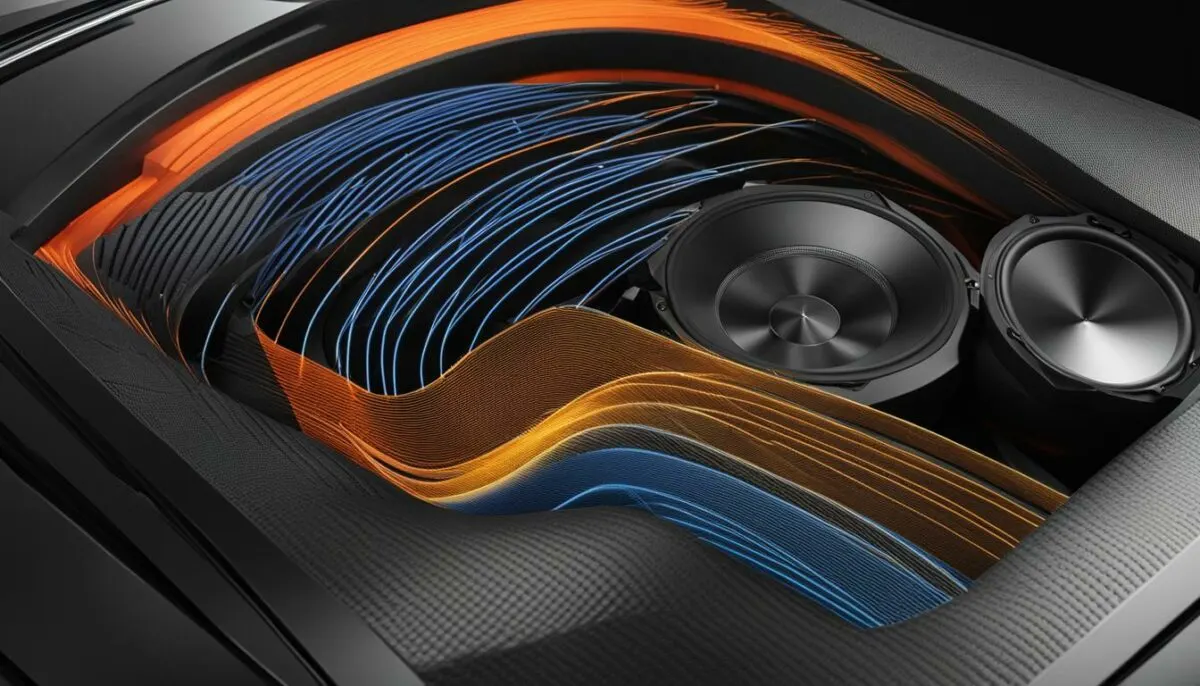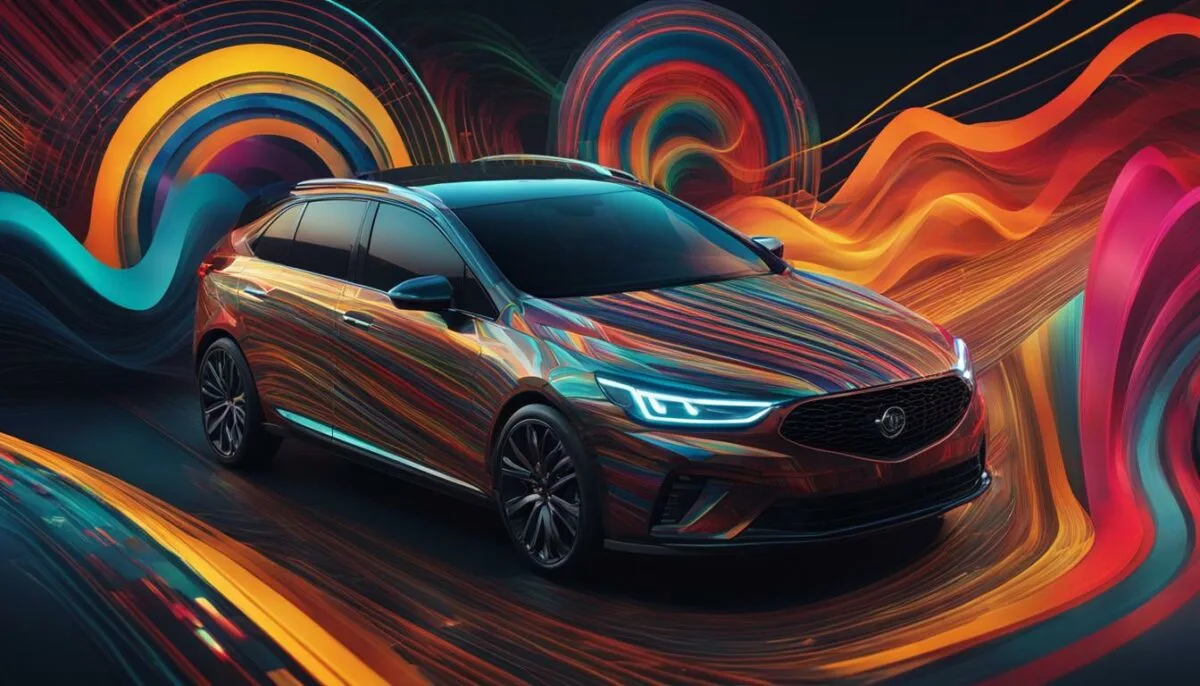When it comes to car audio systems, achieving optimal sound quality is key to a fulfilling audio experience. One question that often arises is whether crossovers are needed to attain this. To answer this question, we must first understand what crossovers are and their role in car audio systems.
Crossovers are electronic components that help divide audio signals and direct them to the appropriate speakers. By doing so, crossovers ensure that each speaker receives the frequencies it is designed to handle, resulting in improved sound reproduction and reduced distortion.
So, are crossovers needed in car audio? The answer is yes. Integrating crossovers into your car audio setup can have a significant impact on sound quality and overall audio performance.
Key Takeaways
- Crossovers are electronic components that divide audio signals and direct them to the appropriate speakers.
- Integrating crossovers into your car audio setup can significantly improve sound quality and overall audio performance.
- Each speaker in a car audio system is designed to handle specific frequencies, and crossovers ensure that these frequencies are delivered accurately.
- Crossovers are essential for achieving optimal sound quality in car audio systems.
- There are various types of crossovers available for car audio systems, and choosing the right one is crucial for optimizing your audio experience.
Understanding Crossovers in Car Audio
Car audio enthusiasts are always looking for ways to improve their listening experience on the road. One essential component of car audio systems that can significantly enhance sound quality is the crossover. A crossover is an electronic circuit that divides an audio signal into different frequency ranges, directing them to specific speakers that are designed to handle those frequencies. The result is improved sound reproduction and reduced distortion, allowing you to enjoy your music to the fullest while driving.
The Benefits of Using Crossovers in Car Audio
There are several advantages to using crossovers in car audio systems:
- Better Sound Quality: Crossovers help eliminate distortion and muddiness in your audio, resulting in a more dynamic and detailed sound.
- Improved Clarity: By directing specific frequencies to each speaker, crossovers ensure that each speaker is playing the frequencies that it is best suited for, resulting in a clearer and more balanced sound.
- Reduced Strain on Speakers: Crossovers help prevent speakers from trying to reproduce frequencies that they are not designed to handle, reducing the risk of damage or distortion.
Considering these benefits, it’s clear that crossovers are a valuable addition to any car audio system.
Types of Crossovers in Car Audio
There are two main types of crossovers used in car audio systems: passive crossovers and active crossovers.
| Passive Crossovers | Active Crossovers |
|---|---|
| These crossovers are built into the speakers and are typically used in lower-end systems. They are less flexible than active crossovers and can introduce extra resistance and capacitance into the circuit, which can affect sound quality. | These crossovers are separate from the speakers and are typically used in higher-end systems. They offer more precise control over frequency distribution and can be fine-tuned to your specific listening preferences. |
While both types of crossovers can improve sound quality, active crossovers offer more flexibility and precision, making them the preferred choice for audiophiles.
“Crossovers help eliminate distortion and muddiness in your audio, resulting in a more dynamic and detailed sound.”
Now that you understand what crossovers are and the benefits they offer, it’s time to explore their importance in car audio systems. Keep reading to discover how crossovers play a crucial role in ensuring optimal sound quality and speaker performance.
Types of Crossovers in Car Audio

Crossovers are essential components of any car audio system, helping to separate audio signals into different frequency ranges and directing them to the appropriate speakers. There are two types of crossovers available for car audio systems:
1. Passive Crossovers
Passive crossovers are the most common type of crossovers used in car audio systems. They are designed to be installed between the amplifier and the speakers and operate without any external power source. Passive crossovers use capacitors, inductors, and resistors to filter out unwanted frequencies and redirect the audio signals to the appropriate speakers.
The advantages of using passive crossovers in car audio systems include their low cost, ease of installation, and compatibility with a wide range of amplifiers and speakers. However, passive crossovers have some limitations, such as a fixed crossover point, which cannot be adjusted to suit specific listening preferences.
2. Active Crossovers
Active crossovers are another type of crossovers used in car audio systems. Unlike passive crossovers, they require an external power source and are installed between the head unit and the amplifiers.
Active crossovers use electronic circuits, such as operational amplifiers and transistors, to split the audio signals into different frequency ranges and direct them to the appropriate speakers. They offer more flexibility than passive crossovers, allowing for adjustable crossover points, slopes, and other tuning options, which can be customized to suit individual listening preferences.
The advantages of using active crossovers in car audio systems include their high level of customization, improved sound quality, and reduced distortion. However, they can be more expensive than passive crossovers and may require professional installation.
Exploring the Importance of Crossovers in Car Audio

Crossovers are integral components of any car audio system and play a crucial role in achieving optimal sound quality. Without crossovers, the audio signals sent to the speakers might contain frequencies that they are not designed to handle, resulting in muddiness, distortion, and reduced clarity.
The importance of crossovers lies in their ability to separate audio signals into distinct frequency ranges and direct them to the appropriate speakers. This ensures that each speaker receives the frequencies it is designed to handle, resulting in clearer and more balanced sound reproduction.
Additionally, crossovers prevent the speakers from receiving frequencies outside of their designed range, which can cause damage to the speakers and reduce their lifespan. By using crossovers, you can prolong the life of your speakers and prevent costly repairs or replacements.
Eliminating Distortion with Crossovers
One of the most significant benefits of crossovers in car audio systems is their ability to eliminate distortion. Distortion occurs when the audio signals sent to the speakers contain frequencies that they cannot handle, resulting in a distorted and muddled sound.
With the use of crossovers, this problem is solved as each speaker receives only the frequencies it is designed to handle, ensuring that the sound reproduced is accurate and distortion-free. This results in a more immersive and enjoyable listening experience, with clear and detailed sound reproduction.
Improving Speaker Performance with Crossovers
The performance of each speaker in a car audio system is dependent on its ability to reproduce specific frequency ranges accurately. Crossovers ensure that each speaker operates within its optimal frequency range, resulting in improved speaker performance and longevity.
By directing appropriate frequencies to each speaker, crossovers prevent overloading and reduce the risk of speaker damage, resulting in a longer lifespan for the audio system. Additionally, the use of crossovers can significantly improve imaging, resulting in a more dynamic and immersive audio experience.
Choosing the Right Crossover for Your Car Audio System
Choosing the right crossover for your car audio system is crucial to achieving optimal sound quality. There are various types of crossovers available, including passive crossovers and active crossovers, each with their respective characteristics and functionalities.
Passive crossovers are typically more affordable and straightforward to install, making them an ideal choice for casual listeners. Active crossovers, on the other hand, offer greater flexibility and control over the audio signals, making them a popular choice among audiophiles and enthusiasts.
Ultimately, the choice of crossover will depend on your budget, listening preferences, and the specifics of your car audio system. Consulting with experts or professional installers can help you make informed decisions and achieve the best possible sound quality.
The Functionality of Crossover Filters in Car Audio

Crossovers are essential for dividing audio signals and directing them to the appropriate speakers in car audio systems. However, it is the functionality of crossover filters that separates the audio signals into different frequency ranges.
There are two main types of crossover filters available for car audio systems: high-pass filters and low-pass filters. High-pass filters allow high frequencies to pass through to the speakers, while blocking low frequencies. Low-pass filters, on the other hand, allow low frequencies to pass through, while blocking high frequencies.
High-Pass Filters
High-pass filters are used to direct high-frequency signals to the appropriate speakers in car audio systems. These filters block low-frequency signals that could cause distortion or damage to small speakers, such as tweeters or mid-range drivers.
For example, if a crossover is set at 5,000 Hz, any audio signals below this frequency range will be blocked from reaching the tweeter, which cannot handle low-frequency signals. Instead, these signals will be directed to the mid-range driver or woofer, which can handle them without distortion.
Low-Pass Filters
Low-pass filters are used to direct low-frequency signals to the appropriate speakers in car audio systems. These filters block high-frequency signals that could cause distortion or damage to large speakers, such as subwoofers.
For example, if a crossover is set at 80 Hz, any audio signals above this frequency range will be blocked from reaching the subwoofer, which cannot handle high-frequency signals. Instead, these signals will be directed to the mid-range driver or tweeter, which can handle them without distortion.
Crossover filters are essential components of crossovers in car audio systems. They ensure that each speaker receives the frequencies it is designed to handle, resulting in optimal sound quality and speaker performance. By understanding the functionality of crossover filters, you can optimize your car audio system for a more immersive listening experience.
Optimizing Your Car Audio with Crossovers

To get the most out of your car audio system, it’s crucial to optimize it with crossovers. By doing so, you can ensure that each speaker receives the frequencies it is designed to handle, resulting in improved clarity, imaging, and overall audio performance. Here are some tips and techniques to optimize your car audio using crossovers:
Experiment with Crossover Settings
Once you have installed your crossovers, it’s time to experiment with the settings to find the optimal configuration for your car audio system. Play your favorite songs and adjust the crossover settings, paying attention to the sound quality. Try different settings for each speaker, making sure that the frequencies are properly divided.
Properly Place Your Speakers
Placing your speakers in the right locations can significantly impact the effectiveness of your crossovers. For example, installing your tweeters close to your ear level will enhance imaging, while placing your mid-range speakers near the front doors can increase mid-bass response. Experiment with different speaker positions to find the optimal placement for each speaker.
Use High-Quality Audio Sources
No matter how well you optimize your car audio system with crossovers, it won’t sound good if you use low-quality audio sources. Make sure you use high-quality audio files and avoid low-bitrate MP3s. Also, use high-quality cables and connections to ensure that the audio signals are transmitted without any interference.
By following these tips, you can get the most out of your crossovers and optimize your car audio system for superior sound quality.
Using Crossovers for Superior Sound Quality in Car Audio

Crossovers are essential components in car audio systems, providing numerous benefits in sound quality and speaker performance. By directing specific frequency ranges to the appropriate speakers, crossovers optimize sound reproduction and reduce distortion, resulting in a balanced and immersive audio experience.
The proper use of crossovers can significantly improve the quality of sound in your car audio, providing enhanced imaging, clarity, and dynamics. With crossovers, your speakers will operate efficiently within their optimal frequency range, eliminating muddiness and improving overall sound quality.
There are various types of crossovers available for car audio systems, ranging from passive crossovers to active crossovers. Choosing the right crossover for your car audio setup is crucial to achieving optimal sound quality and speaker performance.
The Benefits of Using Crossovers for Sound Quality in Car Audio
Using crossovers in your car audio system can bring numerous benefits to sound quality, including:
- Improved clarity and definition of individual instruments and vocals
- Reduced distortion, resulting in cleaner and more accurate audio
- Enhanced imaging, providing a more realistic and immersive listening experience
- More dynamic and detailed sound, highlighting nuances and subtleties in the music
Properly setting up and configuring crossovers in your car audio system can optimize sound quality and speaker performance, achieving the best possible audio experience. Our experts recommend experimenting with crossover settings, choosing the most suitable crossover for your car audio setup, and placing it in an optimal location to minimize noise interference and ensure optimal sound quality.
“Crossovers play a crucial role in ensuring that the right frequencies are directed to the appropriate speakers, preventing distortion and ensuring a balanced and immersive audio experience in your car.”
Don’t hesitate to incorporate crossovers into your car audio system to achieve superior sound quality. Even if you’re not an audiophile, crossovers can significantly enhance your listening experience and make the most of your car audio setup.
Addressing Common Misconceptions About Crossovers in Car Audio

There are many myths surrounding the use of crossovers in car audio systems. Let’s address some of the most common misconceptions:
- Myth: Crossovers are only for advanced audiophiles.
- Fact: Crossovers can benefit anyone who wants to improve the sound quality in their car audio system, regardless of their level of audio expertise.
- Myth: Passive crossovers are always better than active crossovers.
- Fact: Both passive and active crossovers have their advantages and disadvantages, and the choice depends on the specific needs and preferences of the user.
- Myth: Crossovers will fix all sound quality issues in a car audio system.
- Fact: While crossovers can significantly improve sound quality, they cannot fix issues related to poor speaker placement, low-quality speakers, or improper installation.
- Myth: Crossovers are expensive and not worth the investment.
- Fact: Crossovers are available at a range of price points, and even a basic crossover setup can vastly improve audio quality, making them a worthwhile investment for anyone looking to optimize their car audio experience.
By debunking these misconceptions, we hope to encourage more people to explore the benefits of incorporating crossovers into their car audio systems.
Expert Tip:
“Don’t be intimidated by crossovers! They are not as complicated as they may seem, and with a little research and experimentation, you can improve the audio quality of your car audio system significantly.”
Expert Recommendations for Using Crossovers in Car Audio

As with any car audio component, proper installation and configuration of crossovers are key to achieving optimal sound quality. Our experts offer the following recommendations:
- Choose the Right Type of Crossover: Consider the size and configuration of your car audio system to determine whether to use passive or active crossovers. Passive crossovers are suitable for smaller systems with fewer speakers, while active crossovers are ideal for larger systems with more speakers and greater customization options.
- Place Crossovers in the Right Location: Installing crossovers near the amplifiers can lead to improved sound quality, as it minimizes signal loss and interference. Adequate ventilation and secure mounting are also crucial for preventing damage and ensuring consistent performance.
- Choose the Right Crossover Points: Select the crossover points based on the frequency response of your speakers, ensuring that each speaker operates within its optimal range. Experimenting with different crossover points and adjusting them based on your preferences can help achieve the desired sound quality.
- Consider Using High-Pass Filters: High-pass filters can help in reducing distortion and protecting your speakers from low-frequency signals that they cannot handle. Using high-pass filters in conjunction with crossovers can help extend the lifespan of your speakers while improving sound quality.
- Calibrate Your System: Once you have installed and configured your crossovers, it is essential to calibrate your entire car audio system to ensure the best possible sound quality. Conducting a frequency sweep and adjusting the crossover points and other settings accordingly can help you achieve a well-balanced and immersive audio experience.
By following these recommendations, you can leverage the full potential of crossovers in your car audio system and enjoy superior sound quality on the road.
Case Studies: Real-World Examples of Crossovers in Car Audio

If you’re still on the fence about incorporating crossovers into your car audio system, these real-world examples will help illustrate their benefits.
Case Study 1: Reducing Distortion with Crossovers
A car audio enthusiast was experiencing distortion and muddiness in the sound quality of their system. After consulting with a professional, they installed a passive crossover to prevent higher frequencies from reaching their subwoofer, which was not designed to handle those frequencies. The result was a cleaner, clearer sound with reduced distortion, improving the overall audio experience.
Case Study 2: Customizing Sound with Active Crossovers
A car owner who frequently listened to different genres of music desired a more flexible audio system. They opted for an active crossover to allow for greater customization in frequency division and tuning. The active crossover allowed them to fine-tune their system to their preferences, resulting in a more personalized and satisfying listening experience.
| Passive Crossovers | Active Crossovers |
|---|---|
| Simple installation | More complex installation |
| Less customizable | Greater customization options |
| Less expensive | More expensive |
| Suitable for most setups | Ideal for advanced setups and audiophiles |
As you can see, both passive and active crossovers have their advantages, and the choice ultimately depends on your preferences and setup.
These case studies demonstrate how crossovers can significantly improve the sound quality and overall listening experience in car audio systems. By directing specific frequencies to the appropriate speakers, crossovers help eliminate distortion and ensure each speaker operates at its optimal range. Consider incorporating crossovers into your car audio setup to elevate your listening experience.
Future Trends and Innovations in Crossovers for Car Audio

As car audio technology continues to evolve, so do crossovers. The future of crossovers in car audio promises exciting innovations and advancements that will elevate the listening experience to new heights.
Advanced Digital Signal Processing
One of the most significant trends in crossovers for car audio is the implementation of advanced digital signal processing. DSP allows crossovers to be more precise and accurate in dividing audio signals, resulting in improved sound quality and reduced distortion.
With DSP, crossovers can also be more flexible in their configurations, allowing for greater customization and optimization of sound quality for specific car audio setups.
Wireless Integration
Another trend in crossovers for car audio is wireless integration. With the rise of wireless technology, crossovers can now be integrated seamlessly into car audio systems without the need for complicated wiring and installation.
Wireless integration also allows for greater control and adjustment of crossovers through mobile apps and other digital interfaces, making it easier to optimize sound quality on the go.
Expanded Compatibility
Crossovers are also becoming more compatible with a wider range of car audio systems. As car manufacturers continue to incorporate advanced sound systems into their vehicles, crossovers are being designed to work seamlessly with these systems, allowing for improved sound quality and more immersive listening experiences.
Innovative Materials
Crossover design is also being influenced by innovative materials, such as graphene and other advanced composites. These materials offer greater durability, efficiency, and precision, resulting in improved sound quality and longevity of crossover components.
Conclusion
The future of crossovers in car audio is bright, with exciting advancements and innovations on the horizon. As these trends continue to develop, car audio enthusiasts can look forward to even more immersive, dynamic, and engaging sound experiences on the road.
Conclusion
After delving into the world of crossovers in car audio, we can safely say that they are indeed necessary for achieving optimal sound quality. By dividing audio signals and directing them to specific speakers, crossovers help in reducing distortion and producing balanced and immersive audio.
There are various types of crossovers available, including passive and active crossovers, each with its own characteristics and functionalities. It is important to choose the most suitable crossover for your car audio setup to maximize its benefits.
Crossover filters are integral components of crossovers and play a crucial role in separating audio signals into different frequency ranges. By properly setting up and configuring crossovers in your car audio system, you can ensure that each speaker receives the frequencies it is designed to handle, resulting in improved clarity, imaging, and overall audio performance.
It is important to address common misconceptions surrounding the use of crossovers in car audio systems to make informed decisions about incorporating them into your setup. Our experts recommend ideal placement, settings, and integration of crossovers based on their extensive experience and expertise.
Real-world case studies showcase the significant improvements in car audio systems that result from the use of crossovers, while the latest trends and innovations in crossover design and implementation offer a glimpse into the future of car audio.
Whether you are a casual listener or an audiophile, incorporating crossovers into your car audio system can elevate your audio experience to new heights. So, don’t hesitate to explore the possibilities of crossovers in car audio and take your listening experience to the next level!
FAQ
Are crossovers needed in car audio?
Yes, crossovers are essential in car audio systems. They help in dividing audio signals and directing them to specific speakers, resulting in improved sound reproduction and reduced distortion.
What are the benefits of using crossovers in car audio?
The use of crossovers in car audio offers several advantages. They ensure that the right frequencies are directed to the appropriate speakers, preventing distortion and ensuring a balanced and immersive audio experience in your car.
What are the different types of crossovers in car audio?
There are two primary types of crossovers in car audio: passive crossovers and active crossovers. Passive crossovers are built into the speakers or speaker enclosures, while active crossovers require an external power source and offer more precise control over frequency distribution.
Why are crossovers important in car audio?
Crossovers play a crucial role in achieving optimal sound quality and speaker performance in car audio systems. They ensure that each speaker receives the frequencies it is designed to handle, preventing muddiness and improving clarity, imaging, and overall audio performance.
How do crossover filters work in car audio?
Crossover filters are integral components of crossovers, and they help separate audio signals into different frequency ranges. By filtering out unwanted frequencies, crossover filters contribute to the overall sound quality and prevent speakers from being overwhelmed by frequencies they are not designed for.
How can I optimize my car audio with crossovers?
To optimize your car audio with crossovers, it is important to properly set up and configure them. This involves choosing the right type of crossover, determining the optimal crossover points, and ensuring that each speaker is receiving the appropriate frequencies for its design. Consulting with experts or referring to manufacturer guidelines can help you achieve the best results.
Can crossovers improve sound quality in car audio?
Yes, crossovers can significantly enhance the sound quality in car audio systems. By allowing each speaker to operate within its optimal frequency range, crossovers improve imaging, eliminate muddiness, and deliver a more dynamic and detailed audio experience.
What are some common misconceptions about crossovers in car audio?
There are several misconceptions surrounding the use of crossovers in car audio. Some common misconceptions include thinking that crossovers are only necessary for high-end audio systems or that they will automatically improve sound quality without proper setup and configuration. It is important to understand the role and proper implementation of crossovers to dispel such misconceptions.
What are expert recommendations for using crossovers in car audio?
Experts recommend considering the ideal placement, settings, and integration of crossovers in car audio systems. This may involve experimenting with crossover points, considering the sensitivity and power handling of speakers, and fine-tuning the crossover settings to achieve the desired sound quality. Seeking advice from professionals or referring to expert resources can provide valuable insights.
Are there real-world examples of crossovers improving car audio systems?
Yes, several real-world examples demonstrate the significant improvements that can be achieved by using crossovers in car audio systems. These case studies showcase enhanced sound quality, improved speaker performance, and a more immersive audio experience. Learning from such examples can inspire and guide you in incorporating crossovers into your own car audio setup.
What are the future trends and innovations in crossovers for car audio?
Car audio technology is constantly evolving, and crossovers are no exception. Future trends and innovations may include advancements in crossover design, improved integration with digital signal processing, and enhanced flexibility in frequency control. Staying updated with the latest developments can help you anticipate and embrace future possibilities in car audio.